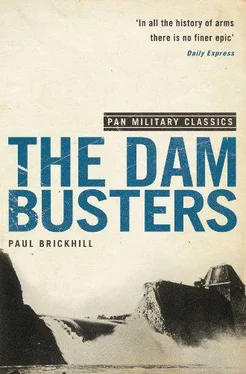For the next five months he experimented whenever he could in the tank at Teddington, an enormous thing well over a hundred feet long. He wanted to find out exactly how to control a skipping missile, so that after a given number of bounces over a given distance he could make it reach a certain given point at a certain minimum speed and height. At this ultimate spot the missile would have to be either slithering across the water or only just a fraction above it. He had to find out the best shape to use and the best combination of weight of missile, and height, speed and power of release. And what a headache it was, too. He had a spring-loaded catapult so that he could measure the force behind it, and began to accumulate an extraordinary number of combinations of heights, shapes, weights, speeds and distances. Hundreds and hundreds of times he shot his little missiles across the surface of the water and they skipped and skipped and skipped in little splashes, some of them foundering in mid-stream, some of them foundering three-quarters of the way along, some of them cracking against the end of the tank nearly fifty yards away at this height or that height, and one or two even bouncing over the end. And all this time Wallis was also trying to do his usual work at Vickers.
He filled notebook after notebook with his records and calculations and slowly, as he pored over them at nights assessing the results, certain conclusions began to emerge from all the figures and facts. For one thing some sort of regular shaped missile gave the most consistent results. Something, for instance, like a round ball, such as a golf ball, because every time it skipped and came down and hit the water again it was the same shaped surface that hit the water. That was the only thing that enabled one to predict a bounce. Any irregular shape would only give irregular bounces. He took to concentrating on firing golf balls and bit by bit found he could so adjust the height and strength of his catapult that he could make a ball slither neatly up to the far wall of the tank. There are ways of calculating from scale experiments how a full-sized object will perform. Or that is, how a full-sized object should perform if everything goes according to plan and nothing has been overlooked. By the middle of 1942 Wallis was satisfied he knew enough to make a 5-ton bomb skip under control for half a mile! It would look something like a big round ball of steel and he didn’t quite know whether to call it a mine or a bomb.
Tizard was pleased, but Tizard was an adviser, not all-powerful; the task was to get executive officials keen. Wallis saw several officials, received tea and courtesy, even compliments, but not enough action to please him. Two high executives in particular who could have started things moving seemed irritatingly cautious.
Then one of the several government operational research committees gave Wallis permission to build six half-size prototypes of his new bomb, purely for experiment, and told him he could convert a Wellington to drop them.
In a few weeks the casings were finished, big steel balls about four feet across. Wallis filled them with a harmless substitute the same weight as RDX, and at 3 p.m. on December 4, 1942, the converted Wellington took off from Weybridge with the first bomb on board and Mutt Summers in the pilot’s seat, Wallis crouched in the nose as bomb-aimer, to test-drop off Chesil Beach on the south coast. They were not going to worry too much this time about precise speed and height. About fifty feet up and about 200 m.p.h. and, for the time being, never mind exactly how far the bomb went. It should, however, bounce cleanly about half-a-mile. Something near enough to that would do for the first test. The first thing was to see whether a few tons of steel ball would bounce according to theory.
Off Chesil Beach Summers dived low over the water, Wallis pressed the button and watched the big black bomb rattle clear of its stowage. It took so long it seemed like slow-motion, and then it hit and vanished in a sheet of hissing white spray. Staring tensely down out of the bomb-aimer’s compartment Wallis watched with painful anxiety for it to appear. Just for a moment nothing seemed to happen and then out of the spray lurched the black ball looking somehow misshapen. It fell back into the water quite quickly, lurched drunkenly up again, hit once more, skipped another short distance and then slithered a few yards and vanished into the green depths. It didn’t seem to have travelled more than about two hundred yards and Wallis looked down, puzzled, not quite knowing what to think. It had worked but not the way it was supposed to. Something was wrong. Summers turned the aeroplane back towards Weybridge and Wallis, on the way back, trying to imagine what could have gone wrong, remembered the misshapen look about the bomb. He decided that the casing had not been strong enough. It must have crushed a little under the impact, making the bounces unpredictable and sluggish. When they landed he ordered the cases of the remaining bombs to be strengthened.
On December 12 he and Summers took off with a strengthened bomb. Off Chesil Beach, Wallis watched the bomb going down, holding his breath, and feeling his mouth dry with anxiety. Again the hissing sheet of spray as it hit, and then: Oh the thrill, out of the spray the black ball came soaring a hundred yards across the water, hit with another flashing white feather of spray and soared out again, hit again, and again, the distances shortening every time until at last, after what looked like nearly half a mile, it slithered to a foaming stop and sank. Summers had banked the aeroplane round and they could both look down on that glorious sight of the long necklace of white foaming scars on the water where the bomb had hit. Wallis had seldom known such a moment of glad triumph. He crawled half-way out of the nose to look up and grin at Summers above in the cockpit. The engines were making too much noise to talk but Summers grinned down at him, gave him the thumbs-up sign and an enormous wink.
In the next three days he and Summers dropped three more bombs and they worked every time. They took a movie cameraman with them on these flights and got undeniable evidence that it worked.
On the strength of that Winterbotham arranged an interview for Wallis with the Ministry of Supply’s scientific tribunal to assess new weapons. The tribunal watched his films and let it be known that the report would be favourable.
With his films Wallis made a new assault on the two cautious officials. They were still non-committal, but it seemed to Wallis a little less inflexibly so.
Slowly the weeks dragged by with no break-through, and Wallis was sinking into despair again when one day he got a call from one of the two cautious ones, giving him permission to go ahead with the preliminary design of a full-sized bomb. The official tempered his joy by telling him not to expect too much.
Further work would depend on whether it would dislocate work on a new bomber.
This was early February, 1943, and the best time to smash the dams was in May, when they were full. There was still just time. Wallis worked late over his plans and on the eighth day had them virtually finished when the bombshell dropped. One of the cautious ones ‘phoned, ordering him to stop work on the big bomb. There was to be no further action on it.
Wallis went grimly next day to the big tank at Teddington, sank two glass air-tight tanks in the water, putting an arc-light in one and inducing a slight young woman to go into the other with a movie camera. She and the camera could just fit in. He fired a missile across the water, and as it slithered against the end of the tank and sank, the girl filmed its under-water progress. It was a beautiful film; clearly it showed the little sphere rolling down what would represent the dam wall deep under the water to the bottom of the tank.
Читать дальше












